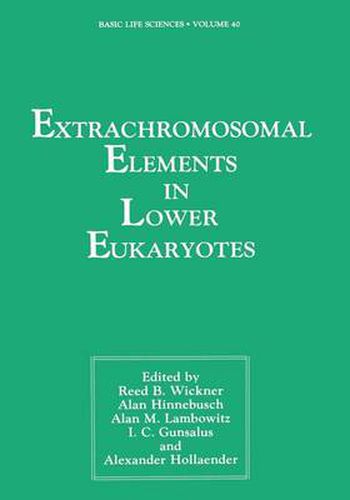Readings Newsletter
Become a Readings Member to make your shopping experience even easier.
Sign in or sign up for free!
You’re not far away from qualifying for FREE standard shipping within Australia
You’ve qualified for FREE standard shipping within Australia
The cart is loading…






This title is printed to order. This book may have been self-published. If so, we cannot guarantee the quality of the content. In the main most books will have gone through the editing process however some may not. We therefore suggest that you be aware of this before ordering this book. If in doubt check either the author or publisher’s details as we are unable to accept any returns unless they are faulty. Please contact us if you have any questions.
Reed B. Wic1mer Section on Genetics of Simple Eukaryotes Laboratory of Biochemical Pharmacology National Institute of Arthritis, Diabetes, and Digestive and Kidney Diseases Bethesda, Maryland 20892 While most genes are chromosomal, the nonchromosomal genes have played a disproportionate role in molecular biology, in part because of their easy accessibility and in part because they represent the most mobile portion of a cell’s genome. This is particularly evident in prokaryotes, where plas- mids and phages have been the central objects of study. The lower eukaryotes, including fungi and yeasts, protozoa, slime molds, algae, and other single-celled nucleated species, have long had an important role in genetic research. They have recently gained dramatic popularity with the development of transformation methods for Saccharomy- ~, Neurospora, Schizosaccharomyces, Dictyostelium, and others of this group. The realization that Saccharomyces has oncogenes, RNA tumor virus- es, estrogens, a polypeptide sex hormone with close homology to human lactate dehydrogenase, intervening sequences, and all the mitotic, mito- chondrial, and other structures typical of so-called higher eukaryotic organisms has confirmed the use of such organisms as model systems. Their use in biotechnology also shows great promise.
$9.00 standard shipping within Australia
FREE standard shipping within Australia for orders over $100.00
Express & International shipping calculated at checkout
This title is printed to order. This book may have been self-published. If so, we cannot guarantee the quality of the content. In the main most books will have gone through the editing process however some may not. We therefore suggest that you be aware of this before ordering this book. If in doubt check either the author or publisher’s details as we are unable to accept any returns unless they are faulty. Please contact us if you have any questions.
Reed B. Wic1mer Section on Genetics of Simple Eukaryotes Laboratory of Biochemical Pharmacology National Institute of Arthritis, Diabetes, and Digestive and Kidney Diseases Bethesda, Maryland 20892 While most genes are chromosomal, the nonchromosomal genes have played a disproportionate role in molecular biology, in part because of their easy accessibility and in part because they represent the most mobile portion of a cell’s genome. This is particularly evident in prokaryotes, where plas- mids and phages have been the central objects of study. The lower eukaryotes, including fungi and yeasts, protozoa, slime molds, algae, and other single-celled nucleated species, have long had an important role in genetic research. They have recently gained dramatic popularity with the development of transformation methods for Saccharomy- ~, Neurospora, Schizosaccharomyces, Dictyostelium, and others of this group. The realization that Saccharomyces has oncogenes, RNA tumor virus- es, estrogens, a polypeptide sex hormone with close homology to human lactate dehydrogenase, intervening sequences, and all the mitotic, mito- chondrial, and other structures typical of so-called higher eukaryotic organisms has confirmed the use of such organisms as model systems. Their use in biotechnology also shows great promise.